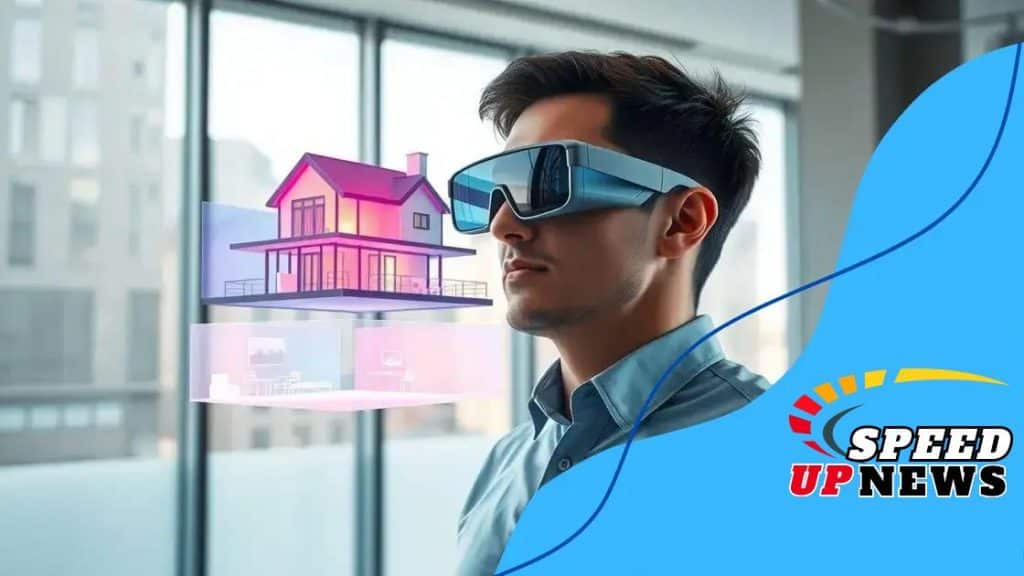Augmented reality transforming real estate marketing

Augmented reality is transforming real estate marketing by enhancing property viewings through immersive experiences, allowing buyers to visualize potential homes with interactive features and virtual staging.
Augmented reality transforming real estate marketing is opening new doors for buyers and agents alike. Have you ever imagined touring a home without stepping inside? This technology makes it possible, making the buying experience much more interactive and engaging.
Understanding augmented reality in real estate
Understanding augmented reality in real estate is essential for both buyers and sellers. It enhances the property viewing experience in ways that traditional methods cannot. This technology blends the physical world with digital enhancements, allowing prospective buyers to visualize homes better.
What is Augmented Reality?
Augmented reality (AR) is a technology that adds digital elements to the real world. For real estate, this means potential buyers can view properties in a more interactive manner. With AR, users can see virtual furniture in an empty room or visualize a property before it’s built.
Benefits of Augmented Reality in Real Estate
- Enhanced Visualization: Buyers can see how a space looks with different layouts.
- Interactive Tours: Virtual tours allow buyers to explore properties from anywhere.
- Saves Time: Reduces the need for in-person visits, streamlining the buying process.
This technology not only makes the viewing experience more engaging but also helps buyers make informed decisions. They can imagine themselves in a space before making any commitments. It’s an exciting prospect for those looking to buy a home.
Moreover, real estate agents can use augmented reality to showcase properties more effectively. By providing interactive tools, they can attract more clients and close deals faster. This innovation marks a significant shift in how real estate is marketed.
For example, some companies have started to implement AR applications that allow users to customize properties. Buyers can change wall colors, replace fixtures, or even rearrange furniture in real-time. These features bring ideas to life and help clients envision their future home.
As the technology continues to evolve, the applications for augmented reality in real estate will likely expand further. The landscape of property marketing is changing, with AR leading the charge into a more interactive and personalized future. Knowing how to leverage this tool can give both buyers and agents a significant advantage in the competitive real estate market.
Key benefits of augmented reality for buyers
The key benefits of augmented reality for buyers are numerous and impactful. This innovative technology transforms how potential homeowners experience properties. It provides a more engaging and informative way to view homes, making the buying process much easier.
Immersive Experiences
With augmented reality, buyers can engage in immersive experiences that traditional methods simply cannot offer. They can envision how different styles of furniture will look in the space or how various colors will change the ambiance. This customization helps buyers feel more connected to the property.
Saving Time and Effort
Augmented reality helps buyers save time by allowing them to narrow down their choices before visiting properties. They can explore multiple homes from their own devices, reducing the hassle of traveling to multiple locations. This convenience makes the entire process more efficient.
- Real-time Visualization: Buyers can make decisions quickly by visualizing changes in real-time.
- Informed Decisions: AR tools provide data alongside visuals, helping buyers understand property features better.
- Market Differentiation: Properties that use AR tools stand out, attracting more interest from potential buyers.
Moreover, augmented reality can increase a buyer’s confidence in their decisions. By seeing a digital representation of what could be, they can visualize themselves living in that space, which may ease anxiety about making such a significant purchase.
Additionally, the ability to explore properties remotely through AR means that buyers can access listings anytime and anywhere. This flexibility encourages more thorough research and informed choices.
As augmented reality continues to evolve, its benefits for buyers will likely expand. The real estate market is becoming more competitive, and those who leverage technology will remain ahead of the game.
How augmented reality enhances property viewings

How augmented reality enhances property viewings is transformative for both buyers and real estate agents. This technology allows for a more interactive experience, helping prospective buyers visualize their future homes.
Interactive Visualizations
Augmented reality provides interactive visualizations that elevate traditional property viewings. Incoming buyers can explore a property from various angles without being physically present. They can see how different layouts and designs look in a given space.
Personalized Tours
This enhances the viewing process by allowing buyers to personalize their tours. They can decide which elements to focus on, such as room configurations or specific features they are interested in. This level of customization makes property tours more relevant to each buyer.
- Virtual Staging: AR can digitally stage homes, helping buyers understand the potential of an empty space.
- Accessibility: Potential buyers can view properties anytime and anywhere without the need for in-person visits.
- Informed Choices: With enhanced visuals, buyers can make quicker and more informed decisions based on what they see.
Moreover, buyers can use AR to visualize renovations, making it easier to see how they can adapt a space to fit their needs. They can get a sense of how furniture will fit or how colors will affect a room’s overall feel.
As agents adopt augmented reality, the process of showing properties becomes more efficient. Agents can engage with clients by showcasing features that might even go unnoticed in a standard tour. This means having the ability to highlight a kitchen’s potential or a backyard’s layout with a simple tap on their device.
Augmented reality ultimately provides a rich viewing experience that enhances engagement. It creates excitement around property listings and helps buyers connect more deeply with homes. As the demand for visual and interactive elements grows, integrating AR in viewings will become essential for agents aiming to stand out in the market.
Real-life examples of AR in real estate
Real-life examples of AR in real estate showcase how this technology can enhance property marketing and improve the buyer experience. Many companies are integrating AR into their sales strategies, resulting in exciting transformations in how we view and interact with homes.
Case Study: Virtual Staging
One notable example is the use of virtual staging software. Companies use AR to digitally stage homes, allowing potential buyers to see how furniture and decor will look in a space. This method provides a stunning visual representation that can attract buyers who struggle to envision a property’s potential.
Interactive Property Tours
Another example is the use of interactive property tours. Some real estate agents offer virtual tours using AR applications. These features enable buyers to explore properties from their couches, giving them the freedom to investigate each room thoroughly. Buyers can walk through the home, look around, and even see how their own belongings would fit.
- Example of Zillow: Zillow now integrates AR features, allowing users to view potential renovations in a home.
- Example of Matterport: Matterport provides 3D home tours that integrate AR, presenting a comprehensive view of the property.
- Example of Redfin: Redfin utilizes AR in their mobile app, enabling buyers to visualize properties with digital enhancements on-site.
These practical applications of augmented reality highlight its effectiveness in real estate marketing. By offering potential buyers unique experiences, sellers can significantly enhance their property listings and stand out in a competitive marketplace.
As AR technology progresses, we can expect many more innovative examples to emerge, further shaping the future of real estate marketing. Companies that adopt these tools will likely find synergies between technology and customer engagement, fostering a more informed and visually appealing sales process.
Future trends of augmented reality in property marketing
Future trends of augmented reality in property marketing are poised to shape the real estate landscape significantly. This technology is evolving rapidly, leading to innovative solutions that enhance both buyer engagement and marketing strategies.
Increased Personalization
One trend is the increasing personalization of AR experiences. As more data becomes available, real estate companies will use this information to tailor property presentations to individual buyers. Personalized features could include customized home designs, local amenities, and neighborhood statistics, all accessible through AR applications.
Integration with Virtual Reality
Another exciting trend is the integration of augmented reality with virtual reality (VR). This combination will offer holistic viewing experiences. Buyers might start with an AR-enhanced property layout and transition to a VR tour of the home. This seamless shift can provide a more comprehensive understanding of what the property offers.
- AR for Renovations: Future tools may allow users to visualize renovations in real-time while touring properties.
- Enhanced Analytics: AR applications are likely to integrate analytics to assess buyer engagement and preferences, helping agents refine their marketing strategies.
- Social Media Integration: AR features on social media platforms will allow users to share their property experiences directly, increasing exposure and interest.
Moreover, the use of AR will expand to mobile devices, making it more accessible to potential buyers. Homebuyers will be able to view properties without the need for expensive equipment, simply using their smartphones. This accessibility will democratize property viewing experiences, reaching a wider audience.
As technology continues to improve, we can expect augmented reality to create more immersive experiences. Future trends will focus on creating engaging interactions that capture buyers’ attention and make the decision-making process easier. By staying ahead of these trends, agents can enhance their marketing efforts and thrive in a competitive market.
FAQ – Frequently Asked Questions About Augmented Reality in Real Estate
How does augmented reality improve property viewings?
Augmented reality creates immersive experiences that allow buyers to visualize and interact with properties, making the viewing process more engaging.
What are the benefits of virtual staging using AR?
Virtual staging using AR helps potential buyers understand the potential of empty spaces by digitally adding furniture and decor.
Can augmented reality help in making informed buying decisions?
Yes, AR provides enhanced visuals and interactive features that allow buyers to make faster and more informed decisions.
What future innovations can we expect in AR for real estate?
Future innovations may include personalized AR experiences, integration with virtual reality, and mobile accessibility for broader audience reach.





